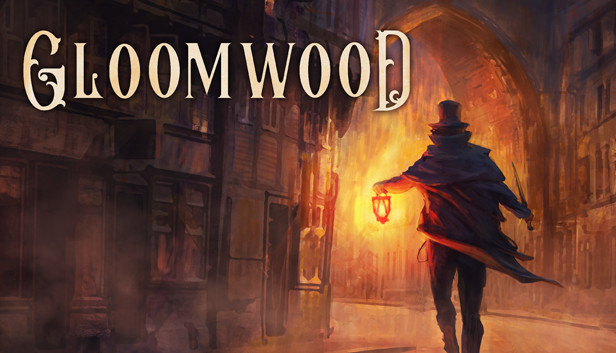Shifty
Member
I was writing up this post as a reply to
 bati
's thread from back in February, but it ended up becoming so long and series-encompassing that I figure I might as well make a new LTTP topic on it.
bati
's thread from back in February, but it ended up becoming so long and series-encompassing that I figure I might as well make a new LTTP topic on it.
For context, this was originally meant to be a couple of sentences for Thief 1, 2 and Deadly Shadows followed by a longer breakdown of my take on the reboot, but it's kind of blossomed into a full series retrospective so there you have it. This is going to be long.
So, the aformentioned thread combined with a recent squeenix steam sale pushed me to play through the Thief series in (almost) its entirety.
The Originals
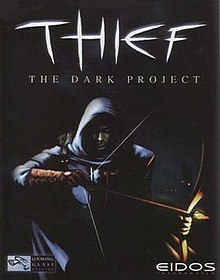

Thief 1 and 2 are sublime. Stealth games developed by Looking Glass Studios and set in a dark medieval fantasy setting that feels fresh even today, they're a tour-de-force of mission design, composed of sprawling environments packed with unique and interesting things to see, secrets to find, and featuring a fantastic Goldeneye-style difficulty system that gives you more objectives instead of tougher enemies.
You play as Garrett, a master thief trained by The Keepers - a shadowy group that works to keep the world in balance - who left due to his disinterest in their ideology. Voiced by Stephen Russell, he's cynical, witty and charismatic, rendering him a likable character despite his illegitimate profession. He provides pre-mission voiceovers and the occasional quip at key points during gameplay, both of which are well written and believable- a pleasant rarity in the face of most modern video game character writing.
The gameplay is first-person stealth with a focus on light, shadow and sound. If a guard is unalerted and you're fully in shadow (indicated by the light gem at the bottom of the screen) you're effectively invisible, though they'll still hear you if you sprint or perform other noisy actions. Garrett is equipped with a non-lethal bludgeon called the blackjack, a shortsword, and a bow. However, you'll largely be avoiding enemies as he is very much mortal- you can't take on more than one guard at once without serious risk of damage or death. If an enemy is unaware then you have the option to knock them out with the blackjack, but if they are then it's time to choose fight, flight, or to reload a quicksave.
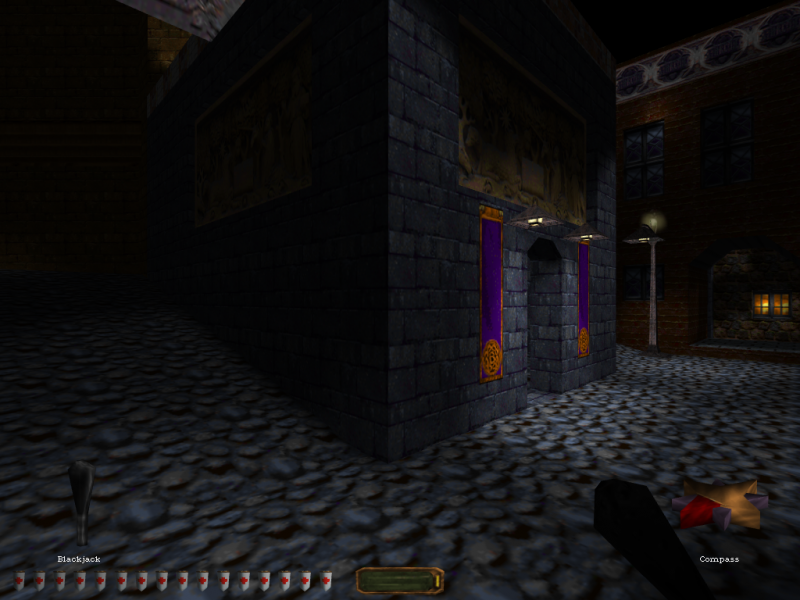
Thief Trivia: The engine that powers Thief (known as The Dark Engine) uses a similar movement system to the one created by John Carmack for Quake, so you can bunnyhop your way through levels like a pro if you know how. (Un)fortunately, they fixed it in the sequel.
When you're not dealing with guards you'll be exploring wide open levels taking anything valuable that isn't nailed down while accomplishing various objectives, such as retrieving a particularly valuable item, breaking someone out of prison or finding evidence with which to blackmail someone, among many others. In pursuit of this, you'll be poking around every nook and cranny looking for hidden rooms, hidey holes, and notes from the inhabitants detailing their daily lives and dirty secrets. The games strike an even balance between guided exploration and exploration out of player curiosity by combining a coarse map with a compass in the UI. The maps' detail varies mission-by-mission depending on how much information Garrett has on the locale, but they give a vague zone-by-zone indication of where you are without becoming more important than using your eyes and looking around.
I feel that level design is one of the things that Thief does best- each location feels rich and cohesive, like it could actually be a functional space rather than simply a set of video game rooms for you to move through. If you find a note mentioning some valuable trinket that's been hidden away, then it's likely that you'll be able to root it out and swipe it with a bit of critical investigation, something that I really enjoyed after years of text logs in other games that act purely as window dressing.
As mentioned above, a Goldeneye 64-style difficulty system is present that changes your objectives based on difficulty rather than simply bumping up enemy health and damage numbers. This makes each difficulty feel unique- for example:
On normal you may be required to infiltrate a mansion and steal a valuable scepter, after which the mission will end.
On hard, you'll have you get in, steal the scepter and 350 gold's worth of loot without killing any innocent servants, and then get back out to the city streets.
On expert, you'll have to get in, steal the scepter and 700 in loot, kill nobody, then get back out.
And that's a fairly simple example- missions can scale from a simple get-in-and-find-thing all the way to instances of sabotage and kidnap on top of that core objective. I almost regret playing the first two games on Expert and seeing everything on my first go round, because I would happily run through both of them again twice over.
While exploring, your primary method of interaction with the world is the 'interact' button. Interactive objects have been common in games for ages now, but Thief leans on them as a mechanic in a considerably deeper sense than most- they're a core part of the level design, allowing for a variety of unique mechanisms such as doors that can be cracked open to peek through, switches that open hidden doors, levers, chests, hidden panels, and even a fully-functional iron casting forge that you can use to create a variety of items during a certain mission. It may sound mundane, but these elements tie into the structure of each area and help embody the cohesion that makes them feel like real spaces. This interaction also covers the act of grabbing loot, which may in some cases be attached to an enemy such as the key on a guard's belt, the purse in his pocket or the arrows in his quiver.
In some cases, you can also use your bow to interact with the environment:
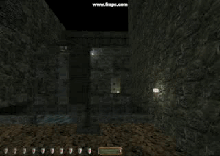
Thief trivia: The act of interaction is referred to by the game engine and DromEd level editor as 'frobbing'. At first glance you'd think that is stands for "function rob" or some other arbitrary code term, but it turns out that it's a real word that came out of MIT and Silicon Valley:
Your secondary means of interaction is your thieving tools, some of which are purchased between missions as you fence off your ill-gotten gains. This incentivises you to steal as much as possible from each level in order to prepare yourself for the next, and allows you to tailor your experience by controlling which tools you start with.
Arguably the most important of these are your lockpicks, which allow you to access places that you shouldn't be without the requisite key. You have two, and each lock requires you to use them in a different order to set each tumbler. It's a simple system - select the appropriate pick and hold the interact button on a lock - but switching back and forth necessitates a degree of concentration and creates tension when you're mid-pick, fully lit up, and hear footsteps approaching.
The second most prominent is collection of special arrows for your bow which can extinguish torches, create a footstep-silencing moss carpet, attach a climbable rope to wooden surfaces or create a distracting noise among other things. These turn your ranged weapon into a utility and represent the core of your sneaking tools:
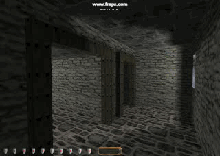
Lastly, there are inventory items such as flash bombs, mines, and a bottle of holy water that will imbue your remaining water arrows with undead-exploding properties. These tend to be more situational, but can be potent when used strategically:
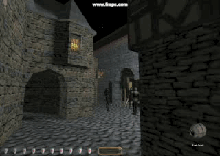
These come together to give the player a large and varied toolkit, which couples with the open 'wide corridor' level design to allow for many different approaches depending on your loadout and playstyle.
The first game's levels are extremely varied, and come across as products of an experimental time in 3D game design for both better and worse. They range from opulent manors populated by servants and guards, to underground caves and crypts full of all sorts of strange fauna and supernatural creatures. Said creatures are a divisive point for some players, as they tend to be harder to read from a stealth standpoint and stray away from the game's apparent core concept: robbing the rich and giving to oneself. Personally I found them a good way to mix things up, but there are a few points in the game that provoke the feeling of "oh no, another monster level" before you dig in and discover that they're actually pretty good.
There are high highs such as:
(I'll tag this as it was a really cool surprise when it happened, but I need to talk about it for the sake of analysis. Light spoiler for the premise of a certain early-game mission.)
Unforunately, it also has some low lows such as "Thieves' Guild" from the gold edition, in which a plan to rob two rival gang leaders of their ill-begotten goods turns into a lengthy slog through an underground hideout that is a little too maze-like for an early-game mission and, on expert, contains the game's single piece of genuinely bad loot design: an unhinted mandatory item that's well-hidden enough to make discovering it difficult.
(You might as well read this because it's a goddamn boondoggle when approached blind but I'll tag it just in case)
Overall I think it's the richer game of the two. From a story and world perspective, it explores of the conflict between the Hammerites and the Pagans - two opposing religious factions - and the gods that they worship. Each mission briefing is preceded by an ominous quote from texts that range from dogmatic scripture to whimsical nursery rhymes with a dark undercurrent. These add texture to the setting and let the player know what kind of ideologies they'll be encountering while sneaking through the world:



The story is veiled in mystery and its major narrative beats are paced perfectly, gradually revealing its true nature to the player through subtle foreshadowing. It all culminates in a final boss encounter that is one of the most unusual and thematically resonant that I've ever seen in a game, a rarity even among less nuanced genres and something that I was not expecting going in.
The second game shares the same core mechanics as Thief 1 with some additional tools and refined mission and interaction design. Garrett can now obtain scouting orbs- throwable cameras that allow you to look around corners and can be retrieved for later use, and vine arrows- a sibling to the rope arrow that can attach to metal grates. Enemy AI has been tweaked to be a little more intelligent and the knockout requirements for the blackjack have actually been reduced slightly, allowing a nimble player to dart into the shadows behind an alerted guard and KO him providing that they are completely concealed and out of enemy sight.
This time, the narrative focus is on the mechanists- a splinter faction of the Hammerites that worship the purity of mechanical engineering over the limitations of the mortal human form. They come across as significantly more sinister and cult-like than their construction-focused brethren, having forcefully infiltrated many aspects of society in the city and created monstrous automatons to act as guards and broadcast 'The Word of Karras, The Woooord of Karras' to anyone within listening range:
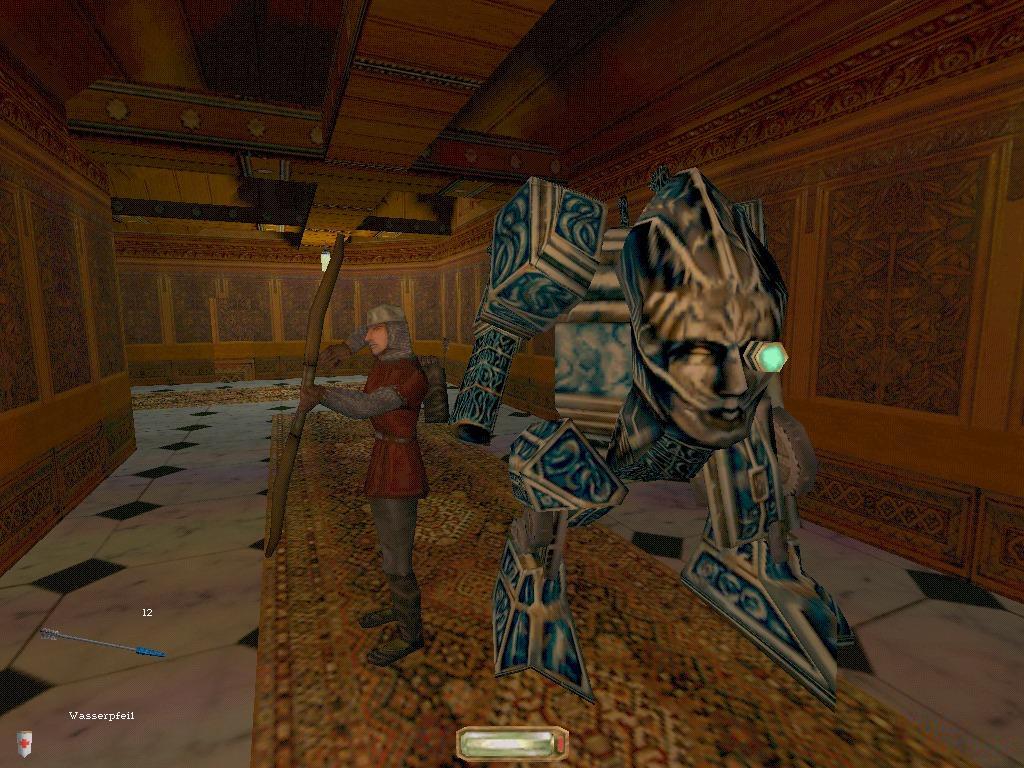
The game dials down on the use of 'monster levels' in favour of these automatons, and has a greater focus on city environments such as a set of dock warehouses complete with their own pirate ship, a bank full of mechanist security systems, and an opera house built above dangerous caverns.
Overall the bar of quality is a bit higher and more consistent than the first game, but Thief 2 is more about the journey than it is the destination. The missions themselves range from okay to excellent and the way the story and world progress from the first is fascinating, with your past actions having had a profound and measurable effect upon the city. Unfortunately the narrative climax doesn't pay off to the same degree as its progenitor, focusing more on the mechanics that cause it than the event itself, but Thief 2 is still a fantastic game despite this.
Thief 1 and 2 are definitely my joint favourites in the series. In fact, trigger warning controversial opinion ahead, I'd go as far to say that I enjoy them more than the original Deus Ex as entries in the Immersive Sim genre. To my eye, they've aged better from a mechanical standpoint and are more digestible thanks to the mission-based structure.
The Black Sheep

Developed by Ion Storm following the closure of Looking Glass due to financial troubles following the release of the nonetheless successful Thief 2, Deadly Shadows starts off as a huge shock to the system (doi hoi pun not intended) because of how janky the mechanics are relative to pure simplicity of the first two.
Built in a new engine, the game is a product of the XB / PS2 / GC era of consolized PC games. The sneaking toolkit of the older games has been shuffled around, sacrificing rope and vine arrows for a more restrictive climbing mechanic that only appears in the late game, and upgrading the moss arrows with the ability to temporarily incapacitate a guard in exchange for alerting them after the fact:
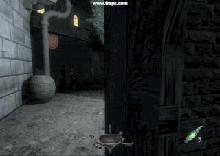
Garrett now has a character model and animations designed to enable third-person view. While this sounds like a nice addition on the surface, it ends up acting in detriment to the core first-person gameplay by giving animation priority over movement. Turning, climbing, leaning and switching gear are all now slower and less responsive, and it feels imprecise. And to make matters worse, guards now function differently and are more alert- if a guard is even slightly suspicious, they become immune to the blackjack until a timer expires and they comment that it must have been nothing.
Despite the first impression, I pushed through for the sake of seeing the end of Garrett's story, and once I'd left the enclosed tutorial section of the game and acclimatized to the jank, it began to feel more like a Thief game.
There are a lot of new ideas, such as an open-city hub with various burglary opportunities, sidequests, and going to shops to manually fence and purchase gear. The open city is the most promising of these and is the most well-executed, adding the hub world aspect of the immersive sim genre to the game, but it falls short of its potential with many pieces of loot respawning in the same places as you progress through the story's nine in-game days, reducing the act of stocking up to a repetitive trip around areas that are known to be profitable.
The game also has a rudimentary faction system, allowing you to improve your standing with the hammerites and pagans by performing certain tasks in the hub area. This only really effects the faction NPCs' disposition toward you- hostile, neutral or friendly to the point of assisting you in combat, and doesn't make a lot of difference outside of some end-game sequences when things start to kick off.
The missions themselves are similar to those in the original games- sneak in, accomplish an objective, sneak out. However, the map has now been reduced to a vague single-page overview of the location that longer gives you an indication of where you are. This makes orienting yourself difficult, and results in a more chaotic 'get through' mentality than the structured 'see, do and steal everything' encouraged by the first two games. In addition, the difficulty modifiers are now simpler, being limited to AI perceptiveness and specific loot requirements such as "get 1800 loot total, at least 400 in gems, and find 3 special loot items" rather than the specific in-world tasks of the first two.
The story this time focuses on a prophecy of an oncoming dark age, and a mysterious serial killer known as "The Hag". It feels more meandering than the first two games, but by the end ramps up to a worthy climax that caps off Garrett's story well and could also have served as a jumping-off point for Thi4f. The writing and voice direction isn't as good as the original games, in particular the loss of nuance in the pagan faction's patois, but it's still recognizable and enjoyable.
Honourable mention goes to Robbing The Cradle, one of the missions toward of the end of the game. Set in an orphanage that was converted into an insane asylum while the orphans were still living there, it's possessed of an atmosphere as thick as treacle and extremely unsettling denizens. Lauded by some as one of the scariest levels ever made, I went in with my expectations set high and still came away quite impressed. I've player other, scarier games (REmake, RE2, RE3, and that one haunted crypt section in Arx Fatalis come to mind) but for the time and genre it's an impressive piece of horror design.
So, while the game comes good by the end if you can get there, it's deeply flawed and the victim of an obviously rough development cycle. It's highly ambitious, but executes poorly and as a result ends up feeling more limited than the first two in a lot of ways.
Even fully patched up with the Sneaky Upgrade fan mod, something that improves things enough that I may not have finished without it, it has a common bug that causes Garrett to semi-randomly slide around instead of walking, preventing you from jumping or crouching until you fall off a ledge, activate the climbing gloves ability or reload a quick save, which takes forever in this engine and is a massive immersion-breaker.
I don't regret playing it, but it stands in contrast to the polish of the games that came before it.
The Reboot

The reboot... It's a well-made game, but I couldn't finish it. Mechanically it's tight if somewhat dumbed-down, graphically it's the best that the series has ever looked, it executes well on the between-missions open city thieving that Deadly Shadows experimented with but didn't do very well, but despite all of that it strikes me as that specific AAA type of bland.
The mechanics are more rigid than they were in the old games. Every action you can do is explicit and is tied to a pre-made set of animations: rope arrow attachment is now restricted to certain pre-placed points in the environment, interactions that would have originally been covered by the frob system are boxed into a limited set of minigames such as picking a lock, or finding the switch hidden behind a painting or in a bookcase. They seem cool the first few times you do them, but after a point the realisation happens that these are the only interactions you'll be having throughout the whole game. This is limited in comparison to the original's systems.
Also, I feel like giving Garrett expert hand-to-hand skills was a mistake. Being able to frontally assault an alerted guard with the blackjack and pull off a flashy KO animation makes him seem like a badass video game action hero rather than the wily mortal that he was originally. It's certainly more approachable, but it contributes to a disconnect between the game's themes and mechanics.
And on the subject of themes, New Garrett has so much less personality than Stephen Russell's portrayal of him. Rebooting and dropping the backstory left him in this awkward place of being a skilled thief without the keepers to act as a narrative foil, and he lacks the charisma to effectively carry that role. Where Old Garrett was a likable anti-hero reluctantly pulled into a larger conflict, New Garrett is a preachy cutpurse who fights The Man because The Man wants to arrest and/or kill every thief in the city. I don't like the new outfit either, because the facemask - while practical - gives him an edgy counter-culture look that would be better suited to someone holding a can of spraypaint than a blackjack.
I mentioned New Garrett being preachy- during the intro Garrett calls out the female lead out on her willingness to kill. This gives the character a narrative bias that was primarily expressed mechanically in the originals, where it was strictly a player choice outside of the higher difficulties at which point it became a mission objective.
And that female lead, yikes. She's an edgy videogame character from top to toe. I get a feeling that the original intent (when the game was still Thi4f) was for her to be
(Deadly Shadows ending spoiler)
which would perhaps have contextualized her dynamic with Garrett, but post-reboot she just seems like an edgy asshole for the sake of edgy assholery, which makes her a pretty poor fit for the damsel in distress role that she's placed in for most of the game.
I certainly don't hate or dislike it as a game, but it misses several key points on what it is to be a Thief game, and I lost interest in going back to it after the first few missions. If you haven't played or liked the originals then it's a competent stealth burgle-em-up that you may enjoy, but it likely won't interest fans of the originals who are looking for more.
The Spiritual Successor
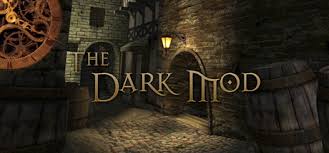
So in lieu of finishing the reboot, I've been giving The Dark Mod a go. It's a fan-made tribute to the originals made in the Doom 3 engine that focuses on user-generated content, and is pretty good. Set in its own universe with lore that's been gradually expanded by the community over time, it feels like a technically modern implementation of the original Thief mechanics.
I've played a few different missions thus far- A New Job, The Tears of St. Lucia, Business As Usual, Lord Dufford's and the first three parts of the No Honor Among Thieves campaign. Mission quality has been mostly good, with all but Lord Dufford's holding up to scrutiny from a level design standpoint and in some cases going above and beyond the original games in terms of density and intricacy.
My main gripe is that the presentation is wildly variable in quality due to its amateur nature. A mission can be well-designed in a structural sense, but have grammar and spelling issues in text copy or painfully amateur voice acting to go along with it. It's still an enjoyable experience, but lacks the polish of the games that inspired it.
I'd love to see a game studio license TDM, get Stephen Russell back and make a proper high-production spiritual successor to the originals in the same vein as 3D Realms with Ion Maiden. It's not going to happen, but a man can dream.
How to play Thief today
Thief 1 and 2 have a fan patch called NewDark that was created by some of the original developers to clean up certain technical aspects and make the game the best it can be on modern systems. There are also various texture packs with varying degrees of faithfulness to the original style.
Thief: Deadly Shadows has a similar patch in the form of the Sneaky Upgrade, a collection of modifications and fixes designed to make the game playable on modern systems, improve its visuals and mitigate some of the more janky elements.
The reboot works out-of-the-box without any fiddling on modern systems by virtue of being a fairly modern game.
The Dark Mod works fairly well out of the box, but can be tweaked for niceties such as unlocked framerate and better VRAM usage by tweaking some .ini files.
You can find out more on each game's respective PCGamingWiki entry:
Thief: The Dark Project - PCGamingWiki
Thief II: The Metal Age - PCGamingWiki
Thief: Deadly Shadows - PCGamingWiki
Thief (Reboot) - PCGamingWiki
The Dark Mod - PCGamingWiki
In short: Thief is a good series. You should play Thief.

For context, this was originally meant to be a couple of sentences for Thief 1, 2 and Deadly Shadows followed by a longer breakdown of my take on the reboot, but it's kind of blossomed into a full series retrospective so there you have it. This is going to be long.
So, the aformentioned thread combined with a recent squeenix steam sale pushed me to play through the Thief series in (almost) its entirety.
The Originals


Thief 1 and 2 are sublime. Stealth games developed by Looking Glass Studios and set in a dark medieval fantasy setting that feels fresh even today, they're a tour-de-force of mission design, composed of sprawling environments packed with unique and interesting things to see, secrets to find, and featuring a fantastic Goldeneye-style difficulty system that gives you more objectives instead of tougher enemies.
You play as Garrett, a master thief trained by The Keepers - a shadowy group that works to keep the world in balance - who left due to his disinterest in their ideology. Voiced by Stephen Russell, he's cynical, witty and charismatic, rendering him a likable character despite his illegitimate profession. He provides pre-mission voiceovers and the occasional quip at key points during gameplay, both of which are well written and believable- a pleasant rarity in the face of most modern video game character writing.
The gameplay is first-person stealth with a focus on light, shadow and sound. If a guard is unalerted and you're fully in shadow (indicated by the light gem at the bottom of the screen) you're effectively invisible, though they'll still hear you if you sprint or perform other noisy actions. Garrett is equipped with a non-lethal bludgeon called the blackjack, a shortsword, and a bow. However, you'll largely be avoiding enemies as he is very much mortal- you can't take on more than one guard at once without serious risk of damage or death. If an enemy is unaware then you have the option to knock them out with the blackjack, but if they are then it's time to choose fight, flight, or to reload a quicksave.

Thief Trivia: The engine that powers Thief (known as The Dark Engine) uses a similar movement system to the one created by John Carmack for Quake, so you can bunnyhop your way through levels like a pro if you know how. (Un)fortunately, they fixed it in the sequel.
When you're not dealing with guards you'll be exploring wide open levels taking anything valuable that isn't nailed down while accomplishing various objectives, such as retrieving a particularly valuable item, breaking someone out of prison or finding evidence with which to blackmail someone, among many others. In pursuit of this, you'll be poking around every nook and cranny looking for hidden rooms, hidey holes, and notes from the inhabitants detailing their daily lives and dirty secrets. The games strike an even balance between guided exploration and exploration out of player curiosity by combining a coarse map with a compass in the UI. The maps' detail varies mission-by-mission depending on how much information Garrett has on the locale, but they give a vague zone-by-zone indication of where you are without becoming more important than using your eyes and looking around.
I feel that level design is one of the things that Thief does best- each location feels rich and cohesive, like it could actually be a functional space rather than simply a set of video game rooms for you to move through. If you find a note mentioning some valuable trinket that's been hidden away, then it's likely that you'll be able to root it out and swipe it with a bit of critical investigation, something that I really enjoyed after years of text logs in other games that act purely as window dressing.
As mentioned above, a Goldeneye 64-style difficulty system is present that changes your objectives based on difficulty rather than simply bumping up enemy health and damage numbers. This makes each difficulty feel unique- for example:
On normal you may be required to infiltrate a mansion and steal a valuable scepter, after which the mission will end.
On hard, you'll have you get in, steal the scepter and 350 gold's worth of loot without killing any innocent servants, and then get back out to the city streets.
On expert, you'll have to get in, steal the scepter and 700 in loot, kill nobody, then get back out.
And that's a fairly simple example- missions can scale from a simple get-in-and-find-thing all the way to instances of sabotage and kidnap on top of that core objective. I almost regret playing the first two games on Expert and seeing everything on my first go round, because I would happily run through both of them again twice over.
While exploring, your primary method of interaction with the world is the 'interact' button. Interactive objects have been common in games for ages now, but Thief leans on them as a mechanic in a considerably deeper sense than most- they're a core part of the level design, allowing for a variety of unique mechanisms such as doors that can be cracked open to peek through, switches that open hidden doors, levers, chests, hidden panels, and even a fully-functional iron casting forge that you can use to create a variety of items during a certain mission. It may sound mundane, but these elements tie into the structure of each area and help embody the cohesion that makes them feel like real spaces. This interaction also covers the act of grabbing loot, which may in some cases be attached to an enemy such as the key on a guard's belt, the purse in his pocket or the arrows in his quiver.
In some cases, you can also use your bow to interact with the environment:

Thief trivia: The act of interaction is referred to by the game engine and DromEd level editor as 'frobbing'. At first glance you'd think that is stands for "function rob" or some other arbitrary code term, but it turns out that it's a real word that came out of MIT and Silicon Valley:
frob (third-person singular simple present frobs, present participle frobbing, simple past and past participle frobbed)
- (jargon, MIT) To manipulate objects considered to be frobs.Hey, frob the switch.
- (jargon, MIT) To manipulate equipment without any knowledge.Hey! Stop frobbing that oscilloscope! You'll break it.
- (jargon, Silicon Valley) To perform a task that is clear to the speaker but too complex or tedious to be explained, so that outside help is not helpful.Why don't you go get lunch? I need to frob with this thing for about 30 minutes and then we'll be good to go.
Your secondary means of interaction is your thieving tools, some of which are purchased between missions as you fence off your ill-gotten gains. This incentivises you to steal as much as possible from each level in order to prepare yourself for the next, and allows you to tailor your experience by controlling which tools you start with.
Arguably the most important of these are your lockpicks, which allow you to access places that you shouldn't be without the requisite key. You have two, and each lock requires you to use them in a different order to set each tumbler. It's a simple system - select the appropriate pick and hold the interact button on a lock - but switching back and forth necessitates a degree of concentration and creates tension when you're mid-pick, fully lit up, and hear footsteps approaching.
The second most prominent is collection of special arrows for your bow which can extinguish torches, create a footstep-silencing moss carpet, attach a climbable rope to wooden surfaces or create a distracting noise among other things. These turn your ranged weapon into a utility and represent the core of your sneaking tools:

Lastly, there are inventory items such as flash bombs, mines, and a bottle of holy water that will imbue your remaining water arrows with undead-exploding properties. These tend to be more situational, but can be potent when used strategically:

These come together to give the player a large and varied toolkit, which couples with the open 'wide corridor' level design to allow for many different approaches depending on your loadout and playstyle.
The first game's levels are extremely varied, and come across as products of an experimental time in 3D game design for both better and worse. They range from opulent manors populated by servants and guards, to underground caves and crypts full of all sorts of strange fauna and supernatural creatures. Said creatures are a divisive point for some players, as they tend to be harder to read from a stealth standpoint and stray away from the game's apparent core concept: robbing the rich and giving to oneself. Personally I found them a good way to mix things up, but there are a few points in the game that provoke the feeling of "oh no, another monster level" before you dig in and discover that they're actually pretty good.
There are high highs such as:
(I'll tag this as it was a really cool surprise when it happened, but I need to talk about it for the sake of analysis. Light spoiler for the premise of a certain early-game mission.)
"Assassins", a mission in which a simple plan to rob the local hammerite temple is derailed when a pair of bumbling assassins ordered to kill Garrett accidentally murder his supplier mid-purchase in a case of mistaken identity, prompting a pursuit across town (with just enough time to clean out the shop if you're quick- it's not like the recently deceased proprietor needs all of that stock anymore, right?) and the ensuing robbery and humiliation of their employer.
To me, this is a fascinating piece of game design because the mission briefing and objective screen don't take it into account. Normally such things are 'non-diagetic', in that they're user interface elements that have an omnipresent level of knowledge about the game world and your objectives therein. Not here- in this case those elements are diagetic, because they represent Garrett's intentions and update on the fly as events unfold and his priorities change.
To me, this is a fascinating piece of game design because the mission briefing and objective screen don't take it into account. Normally such things are 'non-diagetic', in that they're user interface elements that have an omnipresent level of knowledge about the game world and your objectives therein. Not here- in this case those elements are diagetic, because they represent Garrett's intentions and update on the fly as events unfold and his priorities change.
Unforunately, it also has some low lows such as "Thieves' Guild" from the gold edition, in which a plan to rob two rival gang leaders of their ill-begotten goods turns into a lengthy slog through an underground hideout that is a little too maze-like for an early-game mission and, on expert, contains the game's single piece of genuinely bad loot design: an unhinted mandatory item that's well-hidden enough to make discovering it difficult.
(You might as well read this because it's a goddamn boondoggle when approached blind but I'll tag it just in case)
A jeweled bracelet hidden behind a small secret panel at the base of a firepit in one of the gangs' offices.
Overall I think it's the richer game of the two. From a story and world perspective, it explores of the conflict between the Hammerites and the Pagans - two opposing religious factions - and the gods that they worship. Each mission briefing is preceded by an ominous quote from texts that range from dogmatic scripture to whimsical nursery rhymes with a dark undercurrent. These add texture to the setting and let the player know what kind of ideologies they'll be encountering while sneaking through the world:



The story is veiled in mystery and its major narrative beats are paced perfectly, gradually revealing its true nature to the player through subtle foreshadowing. It all culminates in a final boss encounter that is one of the most unusual and thematically resonant that I've ever seen in a game, a rarity even among less nuanced genres and something that I was not expecting going in.
The second game shares the same core mechanics as Thief 1 with some additional tools and refined mission and interaction design. Garrett can now obtain scouting orbs- throwable cameras that allow you to look around corners and can be retrieved for later use, and vine arrows- a sibling to the rope arrow that can attach to metal grates. Enemy AI has been tweaked to be a little more intelligent and the knockout requirements for the blackjack have actually been reduced slightly, allowing a nimble player to dart into the shadows behind an alerted guard and KO him providing that they are completely concealed and out of enemy sight.
This time, the narrative focus is on the mechanists- a splinter faction of the Hammerites that worship the purity of mechanical engineering over the limitations of the mortal human form. They come across as significantly more sinister and cult-like than their construction-focused brethren, having forcefully infiltrated many aspects of society in the city and created monstrous automatons to act as guards and broadcast 'The Word of Karras, The Woooord of Karras' to anyone within listening range:

The game dials down on the use of 'monster levels' in favour of these automatons, and has a greater focus on city environments such as a set of dock warehouses complete with their own pirate ship, a bank full of mechanist security systems, and an opera house built above dangerous caverns.
Overall the bar of quality is a bit higher and more consistent than the first game, but Thief 2 is more about the journey than it is the destination. The missions themselves range from okay to excellent and the way the story and world progress from the first is fascinating, with your past actions having had a profound and measurable effect upon the city. Unfortunately the narrative climax doesn't pay off to the same degree as its progenitor, focusing more on the mechanics that cause it than the event itself, but Thief 2 is still a fantastic game despite this.
Thief 1 and 2 are definitely my joint favourites in the series. In fact, trigger warning controversial opinion ahead, I'd go as far to say that I enjoy them more than the original Deus Ex as entries in the Immersive Sim genre. To my eye, they've aged better from a mechanical standpoint and are more digestible thanks to the mission-based structure.
The Black Sheep

Developed by Ion Storm following the closure of Looking Glass due to financial troubles following the release of the nonetheless successful Thief 2, Deadly Shadows starts off as a huge shock to the system (doi hoi pun not intended) because of how janky the mechanics are relative to pure simplicity of the first two.
Built in a new engine, the game is a product of the XB / PS2 / GC era of consolized PC games. The sneaking toolkit of the older games has been shuffled around, sacrificing rope and vine arrows for a more restrictive climbing mechanic that only appears in the late game, and upgrading the moss arrows with the ability to temporarily incapacitate a guard in exchange for alerting them after the fact:

Garrett now has a character model and animations designed to enable third-person view. While this sounds like a nice addition on the surface, it ends up acting in detriment to the core first-person gameplay by giving animation priority over movement. Turning, climbing, leaning and switching gear are all now slower and less responsive, and it feels imprecise. And to make matters worse, guards now function differently and are more alert- if a guard is even slightly suspicious, they become immune to the blackjack until a timer expires and they comment that it must have been nothing.
Despite the first impression, I pushed through for the sake of seeing the end of Garrett's story, and once I'd left the enclosed tutorial section of the game and acclimatized to the jank, it began to feel more like a Thief game.
There are a lot of new ideas, such as an open-city hub with various burglary opportunities, sidequests, and going to shops to manually fence and purchase gear. The open city is the most promising of these and is the most well-executed, adding the hub world aspect of the immersive sim genre to the game, but it falls short of its potential with many pieces of loot respawning in the same places as you progress through the story's nine in-game days, reducing the act of stocking up to a repetitive trip around areas that are known to be profitable.
The game also has a rudimentary faction system, allowing you to improve your standing with the hammerites and pagans by performing certain tasks in the hub area. This only really effects the faction NPCs' disposition toward you- hostile, neutral or friendly to the point of assisting you in combat, and doesn't make a lot of difference outside of some end-game sequences when things start to kick off.
The missions themselves are similar to those in the original games- sneak in, accomplish an objective, sneak out. However, the map has now been reduced to a vague single-page overview of the location that longer gives you an indication of where you are. This makes orienting yourself difficult, and results in a more chaotic 'get through' mentality than the structured 'see, do and steal everything' encouraged by the first two games. In addition, the difficulty modifiers are now simpler, being limited to AI perceptiveness and specific loot requirements such as "get 1800 loot total, at least 400 in gems, and find 3 special loot items" rather than the specific in-world tasks of the first two.
The story this time focuses on a prophecy of an oncoming dark age, and a mysterious serial killer known as "The Hag". It feels more meandering than the first two games, but by the end ramps up to a worthy climax that caps off Garrett's story well and could also have served as a jumping-off point for Thi4f. The writing and voice direction isn't as good as the original games, in particular the loss of nuance in the pagan faction's patois, but it's still recognizable and enjoyable.
Honourable mention goes to Robbing The Cradle, one of the missions toward of the end of the game. Set in an orphanage that was converted into an insane asylum while the orphans were still living there, it's possessed of an atmosphere as thick as treacle and extremely unsettling denizens. Lauded by some as one of the scariest levels ever made, I went in with my expectations set high and still came away quite impressed. I've player other, scarier games (REmake, RE2, RE3, and that one haunted crypt section in Arx Fatalis come to mind) but for the time and genre it's an impressive piece of horror design.
So, while the game comes good by the end if you can get there, it's deeply flawed and the victim of an obviously rough development cycle. It's highly ambitious, but executes poorly and as a result ends up feeling more limited than the first two in a lot of ways.
Even fully patched up with the Sneaky Upgrade fan mod, something that improves things enough that I may not have finished without it, it has a common bug that causes Garrett to semi-randomly slide around instead of walking, preventing you from jumping or crouching until you fall off a ledge, activate the climbing gloves ability or reload a quick save, which takes forever in this engine and is a massive immersion-breaker.
I don't regret playing it, but it stands in contrast to the polish of the games that came before it.
The Reboot

The reboot... It's a well-made game, but I couldn't finish it. Mechanically it's tight if somewhat dumbed-down, graphically it's the best that the series has ever looked, it executes well on the between-missions open city thieving that Deadly Shadows experimented with but didn't do very well, but despite all of that it strikes me as that specific AAA type of bland.
The mechanics are more rigid than they were in the old games. Every action you can do is explicit and is tied to a pre-made set of animations: rope arrow attachment is now restricted to certain pre-placed points in the environment, interactions that would have originally been covered by the frob system are boxed into a limited set of minigames such as picking a lock, or finding the switch hidden behind a painting or in a bookcase. They seem cool the first few times you do them, but after a point the realisation happens that these are the only interactions you'll be having throughout the whole game. This is limited in comparison to the original's systems.
Also, I feel like giving Garrett expert hand-to-hand skills was a mistake. Being able to frontally assault an alerted guard with the blackjack and pull off a flashy KO animation makes him seem like a badass video game action hero rather than the wily mortal that he was originally. It's certainly more approachable, but it contributes to a disconnect between the game's themes and mechanics.
And on the subject of themes, New Garrett has so much less personality than Stephen Russell's portrayal of him. Rebooting and dropping the backstory left him in this awkward place of being a skilled thief without the keepers to act as a narrative foil, and he lacks the charisma to effectively carry that role. Where Old Garrett was a likable anti-hero reluctantly pulled into a larger conflict, New Garrett is a preachy cutpurse who fights The Man because The Man wants to arrest and/or kill every thief in the city. I don't like the new outfit either, because the facemask - while practical - gives him an edgy counter-culture look that would be better suited to someone holding a can of spraypaint than a blackjack.
I mentioned New Garrett being preachy- during the intro Garrett calls out the female lead out on her willingness to kill. This gives the character a narrative bias that was primarily expressed mechanically in the originals, where it was strictly a player choice outside of the higher difficulties at which point it became a mission objective.
And that female lead, yikes. She's an edgy videogame character from top to toe. I get a feeling that the original intent (when the game was still Thi4f) was for her to be
(Deadly Shadows ending spoiler)
The kid that tries to pickpocket Garrett during the "To see a Keeper is not an easy thing, especially one who does not wish to be seen" scene at the end of Deadly Shadows, mirroring child Garrett's interaction with keeper Artemus at the start of Thief 1 and implying that he would take them in as an apprentice.
I certainly don't hate or dislike it as a game, but it misses several key points on what it is to be a Thief game, and I lost interest in going back to it after the first few missions. If you haven't played or liked the originals then it's a competent stealth burgle-em-up that you may enjoy, but it likely won't interest fans of the originals who are looking for more.
The Spiritual Successor
So in lieu of finishing the reboot, I've been giving The Dark Mod a go. It's a fan-made tribute to the originals made in the Doom 3 engine that focuses on user-generated content, and is pretty good. Set in its own universe with lore that's been gradually expanded by the community over time, it feels like a technically modern implementation of the original Thief mechanics.
I've played a few different missions thus far- A New Job, The Tears of St. Lucia, Business As Usual, Lord Dufford's and the first three parts of the No Honor Among Thieves campaign. Mission quality has been mostly good, with all but Lord Dufford's holding up to scrutiny from a level design standpoint and in some cases going above and beyond the original games in terms of density and intricacy.
My main gripe is that the presentation is wildly variable in quality due to its amateur nature. A mission can be well-designed in a structural sense, but have grammar and spelling issues in text copy or painfully amateur voice acting to go along with it. It's still an enjoyable experience, but lacks the polish of the games that inspired it.
I'd love to see a game studio license TDM, get Stephen Russell back and make a proper high-production spiritual successor to the originals in the same vein as 3D Realms with Ion Maiden. It's not going to happen, but a man can dream.
How to play Thief today
Thief 1 and 2 have a fan patch called NewDark that was created by some of the original developers to clean up certain technical aspects and make the game the best it can be on modern systems. There are also various texture packs with varying degrees of faithfulness to the original style.
Thief: Deadly Shadows has a similar patch in the form of the Sneaky Upgrade, a collection of modifications and fixes designed to make the game playable on modern systems, improve its visuals and mitigate some of the more janky elements.
The reboot works out-of-the-box without any fiddling on modern systems by virtue of being a fairly modern game.
The Dark Mod works fairly well out of the box, but can be tweaked for niceties such as unlocked framerate and better VRAM usage by tweaking some .ini files.
You can find out more on each game's respective PCGamingWiki entry:
Thief: The Dark Project - PCGamingWiki
Thief II: The Metal Age - PCGamingWiki
Thief: Deadly Shadows - PCGamingWiki
Thief (Reboot) - PCGamingWiki
The Dark Mod - PCGamingWiki
In short: Thief is a good series. You should play Thief.

Last edited:

